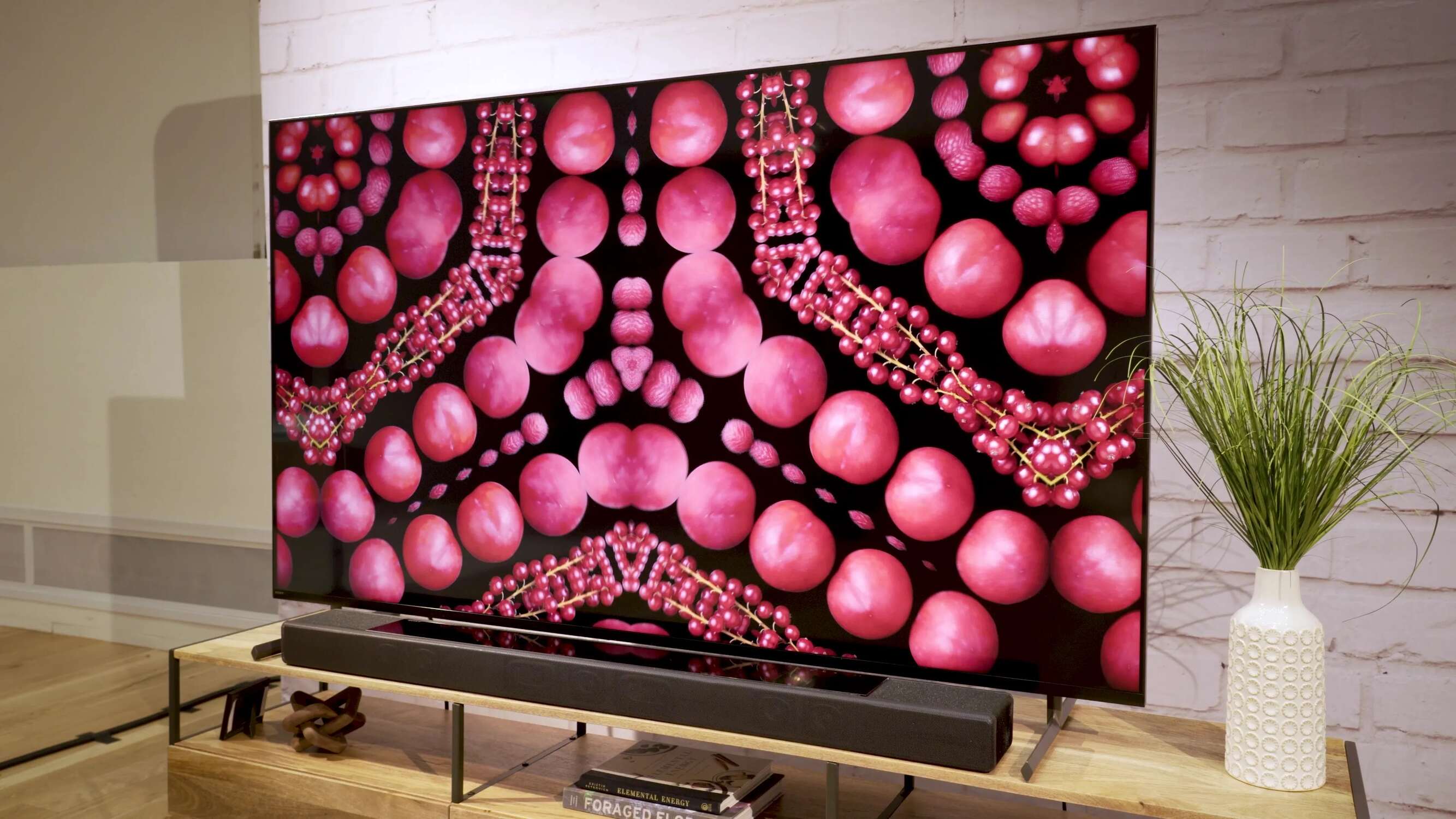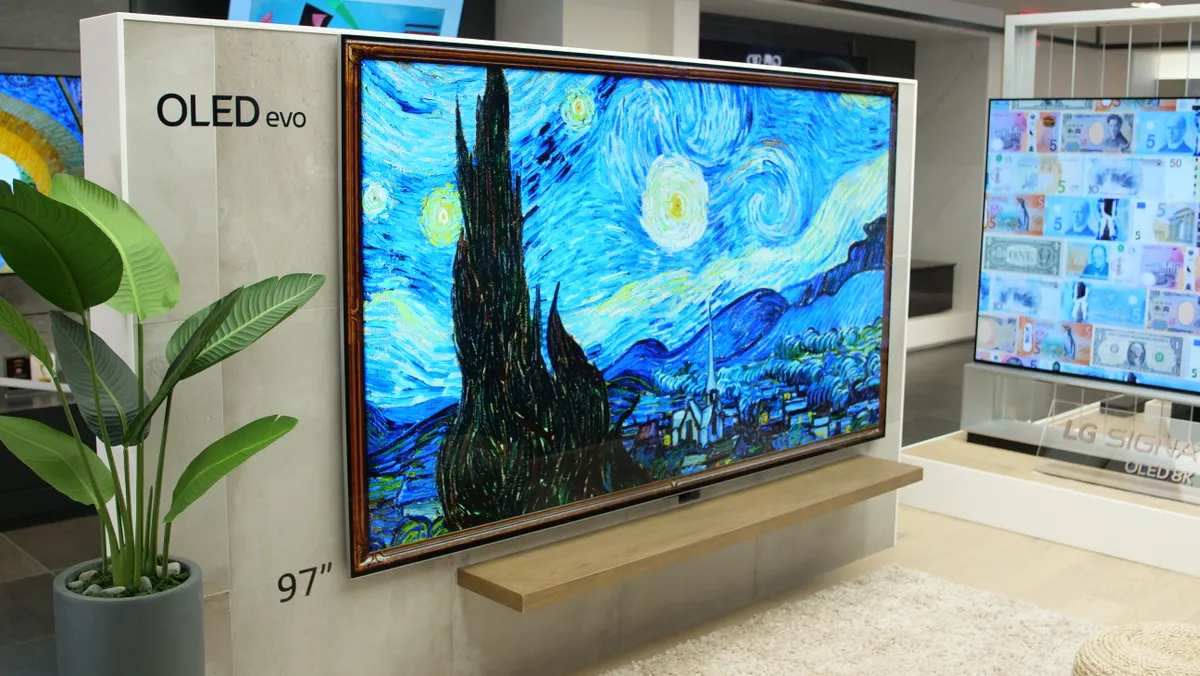Introduction
With the advancements in technology, the world of televisions has undergone a substantial transformation. Gone are the days of bulky cathode ray tube (CRT) TVs; today, we have sleek and sophisticated OLED TVs. OLED stands for Organic Light Emitting Diode, and these cutting-edge displays offer stunning picture quality and vibrant colors that make your viewing experience truly immersive.
Before diving into the topic of how many colors an OLED TV can produce, it’s important to have a basic understanding of OLED technology. Unlike traditional LCD displays that require a backlight, OLED TVs utilize organic compounds that emit light when an electric current is applied. This self-lighting technology leads to perfect black levels and infinite contrast ratios, resulting in rich and lifelike images.
When it comes to color reproduction, OLED technology has a significant advantage over other display types. OLED TVs can produce a wide range of colors, thanks to their ability to individually control each pixel’s brightness and color output. This precision allows for more accurate and vibrant colors, ensuring that every hue is faithfully reproduced on the screen.
However, the number of colors that an OLED TV can produce is not solely determined by the technology itself. The color gamut, which represents the range of colors a display can reproduce, plays a crucial role in this aspect. Let’s delve deeper into the concept of color gamut and how OLEDs excel in this area.
Basic Understanding of OLED Technology
To truly appreciate the color capabilities of OLED TVs, it’s essential to have a basic understanding of the underlying technology. As mentioned earlier, OLED stands for Organic Light Emitting Diode, and it represents a groundbreaking display technology that offers numerous advantages over traditional LCD screens.
At the heart of OLED technology are tiny organic compounds that emit light when an electric current is applied. Unlike LCD displays that require a separate backlight to illuminate the screen, each pixel in an OLED display is individually lit. This results in several significant benefits, including perfect black levels, exceptional contrast ratios, and ultra-thin form factors.
The unique structure of OLED panels allows for individual pixel control, enabling precise control over brightness and color output. Unlike LCD screens, which use color filters to produce colors, OLED pixels emit their own light, resulting in more accurate and vibrant color reproduction. This self-illuminating property of OLED technology eliminates the need for a backlight, making it possible to achieve true black, as individual pixels can simply be turned off to create darkness.
Another advantage of OLED technology is its fast response time. Each pixel can switch on or off in nanoseconds, resulting in smoother motion handling and reduced motion blur. This is particularly advantageous for gaming or watching fast-paced action scenes, where every detail and movement needs to be rendered swiftly and accurately.
Moreover, OLED displays offer wide viewing angles, ensuring that colors and contrast remain consistent even when viewed from off-center positions. This means everyone in the room can enjoy an immersive viewing experience, regardless of where they’re sitting.
In summary, OLED technology revolutionizes the way we view and appreciate television displays. With their self-illuminating pixels, perfect black levels, vibrant colors, fast response times, and wide viewing angles, OLED TVs offer a visual feast that surpasses traditional LCD screens. In the next section, we’ll explore how OLEDs excel in color reproduction and the color gamut they can achieve.
Color Gamut and OLEDs
When it comes to color reproduction, OLED technology shines brightly. The color gamut of a display refers to the range of colors it can accurately reproduce. The wider the color gamut, the more vibrant and lifelike the images on the screen will appear.
OLED displays have a significant advantage over other display technologies when it comes to color gamut. With their ability to individually control the brightness and color output of each pixel, OLEDs can produce a wide spectrum of colors. This extensive range of colors allows for a more immersive and realistic viewing experience, bringing movies, TV shows, and games to life.
To understand the concept of color gamut, it’s helpful to know about the RGB subpixel structure that OLED panels employ. RGB stands for Red, Green, and Blue, which are the primary colors used in light emission and color mixing. In an OLED display, each pixel is composed of subpixels that emit light in these three primary colors. By varying the intensity of each subpixel, a vast range of colors can be achieved.
Compared to other display technologies like LCD, OLEDs have a wider color gamut. LCD displays rely on a backlight and color filters to produce colors, which can result in color limitations and less accurate color representation. In contrast, OLEDs directly emit light, allowing for more precise color reproduction and a broader color gamut.
It’s important to note that the color gamut of an OLED display can vary depending on the specific model and manufacturer. Some OLED TVs excel in reproducing a wide range of colors, while others may have slightly more limited color gamuts. Therefore, it’s recommended to check the specifications and reviews of individual OLED TVs to understand their color capabilities.
In the next section, we’ll explore how OLED TVs display colors and their compatibility with industry-standard color spaces like BT.2020.
The RGB Subpixel Structure
The RGB subpixel structure is a fundamental aspect of OLED displays, and it plays a crucial role in enabling the wide color gamut that OLEDs are known for. In an OLED panel, each pixel is composed of tiny subpixels that emit light in the primary colors: Red, Green, and Blue.
The concept behind the RGB subpixel structure is based on the additive color model, where mixing different intensities of Red, Green, and Blue light can produce a broad range of colors. By controlling the intensity of each subpixel, OLED displays can achieve precise color reproduction, delivering rich and vibrant images.
The subpixels in an OLED display are typically arranged in a matrix pattern, where each pixel is made up of groups of red, green, and blue subpixels. The exact arrangement can vary depending on the manufacturer, but common configurations include RGB, RGBW (with an additional white subpixel), or a diamond-shaped pattern known as PenTile. These configurations aim to optimize color accuracy, resolution, and power efficiency.
The individual control of each subpixel allows OLED displays to create millions of colors. By adjusting the brightness and intensity of the red, green, and blue subpixels, the display can reproduce a vast spectrum of hues. This high level of control not only results in vibrant and lifelike images but also enables smooth color transitions and precise color accuracy.
OLED’s RGB subpixel structure also contributes to the display’s ability to produce true black. Since each individual pixel can be turned off when displaying black, there is no need for a backlight like in LCD displays. As a result, OLED panels can achieve perfect black levels, enhancing the contrast and overall visual experience.
It’s worth mentioning that advancements in OLED technology continue to improve the RGB subpixel structure, leading to even better color reproduction capabilities. Manufacturers are constantly refining the arrangement of subpixels to enhance image quality, reduce color degradation, and achieve more accurate color representation.
In the next section, we’ll explore how OLED displays compare to LCD displays in terms of color gamut and the benefits of using OLED technology for achieving a wider color range.
OLED vs. LCD: Which Offers a Wider Color Gamut?
When it comes to color gamut, OLED displays have a clear advantage over LCD screens. While LCD (Liquid Crystal Display) technology has made significant advancements, OLEDs still reign supreme in terms of their ability to reproduce a wider range of colors.
LCD displays rely on a backlight to illuminate the screen, and each pixel acts as a filter to control the amount of light that passes through. This filtering process can result in limitations in color reproduction, as the filters may not be able to accurately represent certain colors. Additionally, the backlight itself can introduce color inconsistencies, affecting the overall color gamut of the display.
In contrast, OLED displays emit light directly from each pixel, eliminating the need for a backlight and color filters. OLEDs can individually control the brightness and color output of each pixel, leading to more accurate and vibrant color reproduction. This capability allows OLEDs to achieve a wider color gamut, accurately representing a broader spectrum of colors.
The wider color gamut of OLEDs means that colors appear more vibrant and lifelike on the screen. From bold and saturated hues to subtle shades and gradients, OLED displays excel at faithfully reproducing colors. This is especially evident when viewing content that is specifically designed to take advantage of a wider color gamut, such as HDR (High Dynamic Range) videos and photos.
While LCD displays have also made strides in improving color gamut and color accuracy, OLEDs still offer a definite edge in this area. However, it’s important to note that not all OLED displays are created equal. The color gamut performance can vary between different OLED models and manufacturers.
To make an informed decision, it’s essential to consider factors beyond color gamut, such as contrast ratio, viewing angles, response time, and overall picture quality. These aspects can impact the visual experience and should be evaluated alongside color gamut when choosing between an OLED and an LCD display.
In the next section, we will explore how OLED TVs display colors and their compatibility with the BT.2020 color space.
Displaying Colors on OLED TVs
OLED TVs are renowned for their ability to deliver stunning colors and exceptional picture quality. When it comes to displaying colors, OLED technology offers impressive precision and accuracy, ensuring that every hue is faithfully reproduced on the screen.
As mentioned earlier, OLED displays utilize individual pixels that emit light directly. These pixels can independently adjust their brightness and color output, providing precise control over the colors displayed. Whether it’s vibrant reds, deep blues, or subtle shades, OLED TVs are capable of rendering a wide range of colors with remarkable accuracy and clarity.
To display colors, OLED TVs rely on color information provided by the content source, such as a Blu-ray disc or streaming service. The TV processes this color information and adjusts the intensity of the subpixels (red, green, and blue) to recreate the colors as accurately as possible.
OLED TVs also support various color profiles, such as sRGB and DCI-P3, which are industry-standard color spaces used in different applications. These color profiles define the range of colors that can be reproduced, ensuring consistency across different devices and platforms. By supporting multiple color profiles, OLED TVs can accurately display colors as intended by content creators.
Additionally, OLED TVs often offer color enhancement features or picture settings that allow users to adjust the color reproduction according to their personal preferences. These settings can include options to boost color saturation, adjust color temperature, or enable specialized modes like cinema mode or gaming mode, which optimize colors for specific content types.
It’s important to note that the quality of the source content can also significantly impact the perceived colors. High-quality content with accurate color grading and mastering will showcase the full capability of OLED displays, while lower-quality content may not fully harness the potential of the technology.
To ensure the best color performance, it’s recommended to calibrate the OLED TV using professional tools or by consulting a calibration expert. This process adjusts color levels, gamma, and other settings to achieve accurate and consistent color reproduction. Calibration can help bring out the true potential of an OLED TV and enhance the viewing experience.
In the next section, we will explore the BT.2020 color space and its significance for OLED TVs in achieving an expanded color range.
The BT.2020 Color Space and OLEDs
The BT.2020 color space is a standard defined by the International Telecommunication Union (ITU) that represents a significantly expanded color gamut compared to previous standards. It was specifically designed to accommodate the capabilities of the latest display technologies, including OLEDs, to provide a more immersive and realistic viewing experience.
OLED displays, with their ability to reproduce a wide range of colors, are well-suited for the BT.2020 color space. This expanded color gamut allows OLED TVs to deliver more vivid and lifelike colors, bringing content to life with enhanced realism.
The BT.2020 color space encompasses a larger portion of the visible spectrum, including more saturated and intense colors. This broader color range enables OLED displays to accurately reproduce colors that were previously outside the reach of traditional display technologies.
However, it’s important to note that while OLED TVs can support the BT.2020 color space, the content itself must also be encoded in BT.2020 or a compatible color space to fully take advantage of it. Content creators, such as filmmakers or game developers, need to shoot, edit, and master their content using the BT.2020 color space to ensure that the colors are captured and displayed accurately.
It’s worth mentioning that the majority of today’s content, including movies, TV shows, and streaming services, are still primarily produced in the narrower color gamut of the Rec.709 color space. While OLED displays can convert Rec.709 content to fit within their wider color gamut, the true potential of the BT.2020 color space is best realized when viewing content specifically mastered in BT.2020.
To deliver this expanded color range, OLED TVs must accurately map the colors from the source content to their own color reproduction capabilities. This process, often referred to as color mapping or color management, ensures that the colors are faithfully represented on the screen, providing a visually stunning and realistic viewing experience.
OLED displays, with their inherent ability to reproduce a wide range of colors, are well-suited for the BT.2020 color space. As content creators and technology continue to adapt to this expanded color gamut, OLED TVs will continue to offer viewers a more immersive and vibrant color experience.
In the next section, we will explore the importance of color calibration for OLED TVs, and how it can further enhance the color performance and accuracy.
Expanding the Color Range: HDR Capabilities of OLED TVs
HDR, or High Dynamic Range, is a feature that enhances the contrast and color range of an image, providing a more realistic and immersive viewing experience. OLED TVs excel in HDR playback, thanks to their ability to reproduce a wide color gamut and deliver exceptional contrast ratios.
HDR content is specifically mastered to take full advantage of the expanded dynamic range. It includes a wider range of luminance levels, from deep blacks to bright highlights, allowing for more detail in both shadows and highlights. This increased dynamic range enhances the overall visual impact, making the image appear more lifelike and vibrant.
OLED displays, with their self-lit pixels and ability to achieve perfect black levels, are well-suited for HDR content. The OLED technology allows for pixel-level dimming, meaning that each individual pixel can be turned off or on with precision. This capability results in exceptional contrast ratios, accentuating the subtle details and enhancing the visual experience when viewing HDR content.
Additionally, OLED TVs support industry-standard HDR formats, such as HDR10 and Dolby Vision. These formats provide the necessary metadata to optimize the display’s performance, ensuring accurate tone mapping and delivering the intended HDR experience.
In terms of color reproduction, HDR content takes full advantage of the wide color gamut of OLED displays. HDR content can contain an expanded range of colors, more accurately representing the colors found in reality. OLED TVs have the capability to faithfully reproduce these vibrant and nuanced colors, making the HDR experience more visually stunning and engaging.
It’s important to note that while the HDR capabilities of OLED TVs are impressive, not all content is produced in HDR. The availability of HDR content varies across different platforms, and it may require a subscription to a streaming service or the purchase of Blu-ray discs specifically encoded in HDR.
To fully enjoy the HDR capabilities of an OLED TV, it’s recommended to seek out HDR content, whether it’s movies, TV shows, or games, that are labeled as HDR compatible. These HDR-enhanced visuals, combined with the exceptional color reproduction and contrast performance of OLED displays, offer a truly immersive and breathtaking viewing experience.
In the next section, we will explore the importance of color calibration for OLED TVs and how it can further enhance the color accuracy and performance of these displays.
The Importance of Color Calibration
Color calibration is a crucial step in unlocking the full potential of an OLED TV’s color performance. Calibration ensures that the colors displayed on the screen are accurate, consistent, and faithful to the original source content. While OLED displays are known for their vibrant and accurate colors out of the box, calibration fine-tunes the display settings to achieve even greater color accuracy.
One of the primary reasons for color calibration is to account for any variations in color reproduction between different OLED TVs. Each display panel may have slight variations in color temperature, white balance, and color accuracy. Calibration adjusts these settings to ensure a consistent color experience, regardless of the specific unit.
Professional calibration involves using specialized tools and software to measure and adjust the display’s color performance. This process often includes adjusting parameters such as gamma, color temperature, and color points to match industry-standard values. By doing so, the colors are rendered more accurately, resulting in a more natural and lifelike viewing experience.
Color calibration is particularly crucial in professional settings, such as film production or graphic design, where accurate color representation is essential. Content creators and designers rely on precise color calibration to ensure that their work looks as intended across different devices and platforms.
For everyday users, color calibration can still greatly enhance the viewing experience. Whether it’s enjoying movies, sports, or playing games, a well-calibrated OLED TV can reproduce accurate colors, offering a more immersive and engaging visual experience.
It’s worth noting that while professional calibration offers the most accurate results, there are also user-friendly calibration tools and settings available to users. Many OLED TVs come with built-in calibration options or presets that allow users to adjust the color settings according to their preferences.
Regular recalibration is also recommended as the display’s color accuracy can change over time due to factors such as aging or prolonged usage. It’s advisable to recalibrate every few months or when significant changes in color accuracy are noticed.
By investing in color calibration, users can ensure that their OLED TVs deliver the best possible color performance, providing a visually stunning and accurate representation of the content they are viewing.
In the next section, we will summarize the key points discussed and reiterate the benefits of OLED technology in achieving exceptional color reproduction.
Conclusion
OLED technology has revolutionized the world of television displays, offering exceptional color reproduction and vibrant visual experiences. Throughout this article, we have explored the capabilities of OLED TVs in terms of color gamut, the RGB subpixel structure, and their ability to display colors accurately and vividly.
OLED displays, with their self-lighting pixels and individual pixel control, can produce a wide range of colors with precision. Compared to LCD screens, OLEDs have a clear advantage in color gamut and color accuracy, making them the preferred choice for those seeking a more immersive and realistic viewing experience.
The RGB subpixel structure of OLED displays allows for millions of colors to be displayed, resulting in lifelike images with accurate color reproduction. The ability to display true black, along with the expanded color range supported by the BT.2020 color space, further enhances the OLED TV’s visual performance.
OLED displays also excel in HDR capabilities, delivering enhanced contrast, brighter highlights, and a more extensive range of colors for breathtaking HDR content. With HDR compatibility and support for industry-standard formats, OLED TVs can showcase the full potential of HDR content, providing viewers with an immersive and visually stunning experience.
While OLED technology offers remarkable color performance out of the box, color calibration is important to ensure accurate and consistent color reproduction. Calibration, whether done professionally or using user-friendly tools, fine-tunes the display settings and optimizes color accuracy, contributing to an even more impressive visual experience.
In conclusion, OLED technology continues to push the boundaries of color reproduction, offering vibrant and lifelike images that captivate viewers. Whether you’re watching movies, playing games, or simply enjoying your favorite TV shows, OLED TVs provide an immersive visual journey with their exceptional color gamut, precise color reproduction, and support for advanced technologies like HDR. So, sit back, relax, and let the true colors of OLED technology enrich your viewing experience.

























